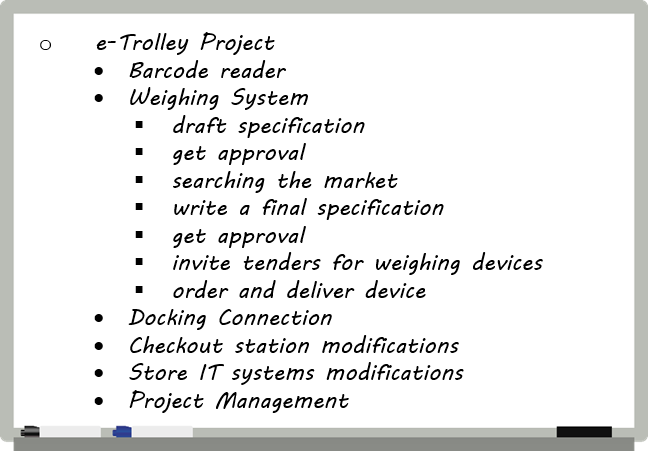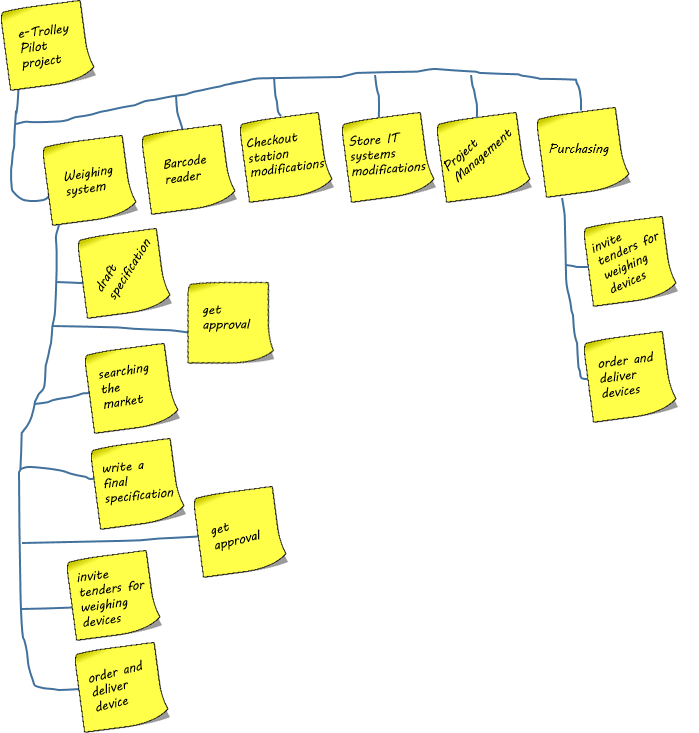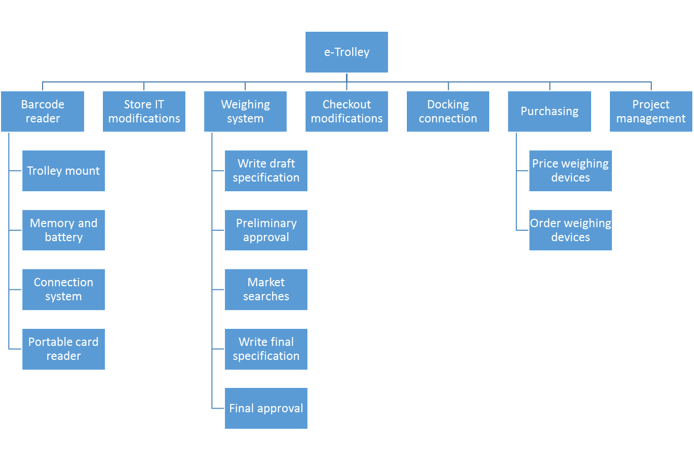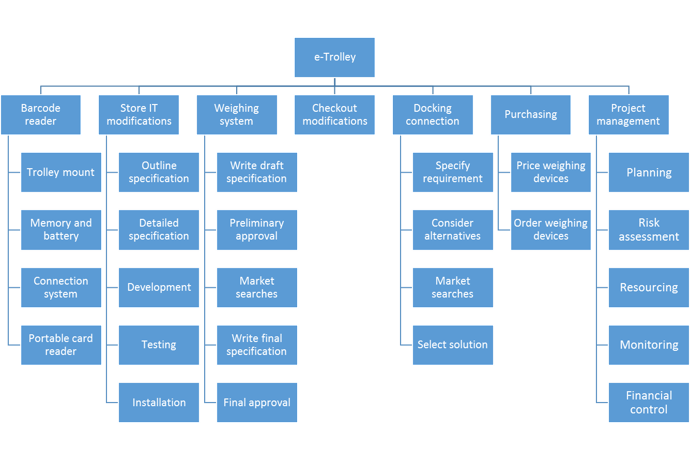Two weeks pass before Anna assembles the working parts of Mike in her own office to discuss the parts that go into the project. She deserves a medal for so doing.
Mike is there still slightly confused between his twin roles of sponsor and weighing specialist. Anna has got him ‘on-side’ by telling him that he is in the best position to make sure everything they will eventually need is listed across the whole project. This has got him away from his precious scales for long enough to see all the other components of the project all of which are vital to success.
Anna starts by explaining that she now plans to develop a product breakdown structure and then a work breakdown structure.
Anna and Mike are not very clear about this technique so she visits the framework and gets information on organisational, product and work breakdown structures.
An organisation breakdown structure (OBS) shows the people in an organisation and how they relate to each other.
Anna thinks that she might prepare an OBS for the project team.
A Product Breakdown Structure (PBS) shows the component parts of a product grouped into neat headings. For example, a bicycle.
A work breakdown structure (WBS) shows the work that is required to be done to achieve a project grouped into neat headings. The example used is preparing a meal for six.
Anna and Mike sit quietly and study the examples.
Mike thinks about how he has applied the PBS technique to weighing scales more than once and Anna thinks that whoever wrote that example of a WBS was probably a male who didn’t know much about cooking and certainly didn’t understand the concept of clearing away and washing up after a meal.
Anna suggests that they start building their own structure and in a very Anna style, she has already broken the project down into 6 parts each of which relates to the technical divisions of her organisation. Were she not constrained by this she might have started off in many different ways but the organisation is what it is and it will probably suit the kind of work it is designed to perform.
Anna can visualise the WBS which, if we could peek into her mind, would look currently like this:
- e-Trolley Project
- Barcode reader
- Weighing System
- Docking Connection
- Checkout station modifications
- Store IT systems modifications
The first thing she realises is that she has missed out project management so she mentally adds it.
She is focusing on the major components and this has given her the first level of breakdown. It therefore follows that there will be activities like design, specification, procure and test for each of these components. Some repetition is inevitable.
Mike, the project’s weighing expert, is the team leader of a group of people who specialise in hardware of this kind and he starts the ball rolling by talking about, of course, his favourite topic.
He says: ‘We need to start off this part of the project by writing a draft specification, getting approval, searching the market, writing a final specification, getting final approval, inviting tenders for weighing devices, placing and order and getting delivery so as to build them into the new trolleys.’
Anna is stunned. Mike has managed to talk about the project in project management terms and has not wondered too far off into the technical issues of the weighing device.
Anna quickly sketches all this on a white board she has organised for the meeting and the WBS is now looking like this:

Anna lets Mike rattle on as this is useful stuff but then she realises that in his role as the weighing team leader, he has already covered some of the commercial parts of the project – for example sourcing the devices - work which is certain to be carried out by the purchasing group.
She also realises it is hard to keep the white board display tidy so she gets some Post-It notes, lists one item per sheet and looks around for something to stick them on. She weighs the pros and cons of a handy office wall, the white board and a passing, slow moving employee and opts for the white board as someone could easily brush against the office wall and ruin the work. Her desire to get close to that particular, unattractive, slow moving employee is down there with pulling her own teeth out.
She also adds a new heading called ‘Purchasing’ and puts a couple of items under that new heading remembering to have a chat with the purchasing group about this project. She changes the title to the e-Trolley Pilot project.

The conversation moves on. They talk about portable barcode readers and remind themselves that these trolleys are going to need their batteries charging occasionally. There are no specialists on the docking idea within the company and they agree that someone needs to be found.
They phone the IT team where they find Max who is ready to nip round for a discussion. One of Mike’s team gets called in to help.
When Max arrives he waxes lyrical about the modifications required to the store computer systems. So as far as barcode reader hardware goes we now have four further post-its.
- Barcode reader
- Portable barcode reader
- Trolley mount
- Memory and battery module
- Connection system
Anna’s role at these sessions is a facilitator. She is no expert on these systems but she is good at getting people to think ahead. She asks questions and prods to help Mike find out what needs to be done to get this project to its conclusion.
A question she often asks is: ‘What have we over-looked?’
The testing discussion focuses on a technical issue. They have some problems with the docking concept. They feel that a radio link might be better so that as an e-Trolley nears the checkout it will register its presence and create a link to the till. The alternatives involve some kind of docking connector on the trolley and checkout point or even a cable on the check-out that connects to a plug on the trolley. They all agree that whatever system is selected it will need considerable testing prior to any real life roll out.
Anna quietly listens for some time, enough time to ensure that there are answers and not an insurmountable problem.
She eventually steps in to say about this one issue: ‘This is a real problem but not one that doesn’t need to be addressed today. There are answers and I am sure the team will find some clever ones but there will be time in the project to resolve this technical issue. I will also recognise this as a technical risk.’
She does not belittle the problem but does postpone it. The techies feel slightly aggrieved but glow in Anna’s confidence that they will crack that problem.
She does however note that a test environment needs to come from somewhere long before they go into production and that there could be a risk of delay here.
There is also a discussion about the sequence of some activities.
Max starts asking all sorts of questions: ‘Can we test the system before installation or do we have to set the whole thing up on site before we can run proper tests? Do we design the software first and then specify the barcode device or is the sequence the reverse?’
People do often start to worry about when these activities are going to happen and how long they will take.
Again, Anna listens to these discussions but then puts down her foot to say that all she needs to do now is to get a list of the activities, the sequence can come later and is not important in a WBS.
Anna has little interest at the moment in installation and documentation and figures that the project management branch of the breakdown structure will be a no-brainer, so she collects up her Post-It notes, finds a desk and draws up the diagram to date. It looks like this:

Later than day Anna sits on a train which in turn sits on a track alongside a field containing a number of mildly curious cows. The train seems to have no current plans to move anywhere due, according to the guard’s announcement to ‘operational reasons’. Anna raises the question in her mind: ‘What other kinds of reasons are there?’
Unlike the train, the cows seem free to move at will.
Anna uses the time and the remaining power in her laptop’s battery to expand the other parts of the WBS to her own satisfaction.

She mails this to all concerned asking for input, advice and corrections. She starts to think about when all of these steps will happen.
Thanks to Geoff Reiss for contributing this book





